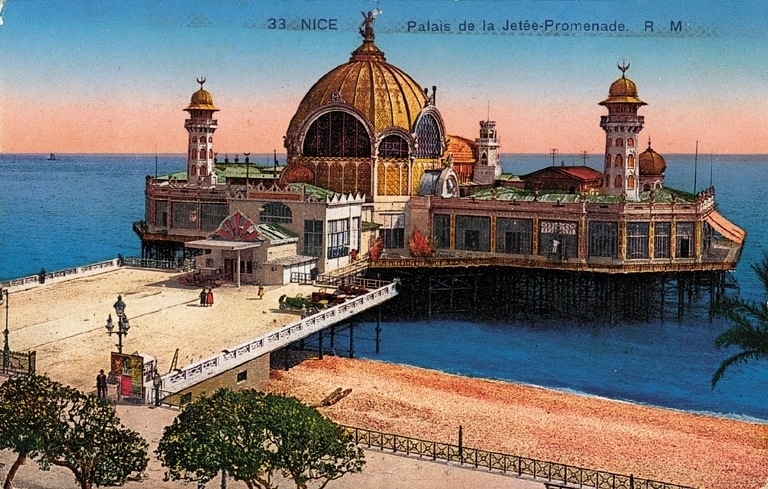
25 Nov The Casino de la Jetée-Promenade
Barely more than fifty years, is the time that the Casino de la Jetée – Promenade, the dazzling symbol of winter vacation, stood proudly on the edge of the Baie des Anges. Appreciated or criticised, the oriental glass palace, the temple of wonders became an elegant city landmark of Nice, a dreamy entrance to the Promenade des Anglais. Casino de la Jetēe’s history is a tormented one, one that speaks of a great success and a horrible ruin.
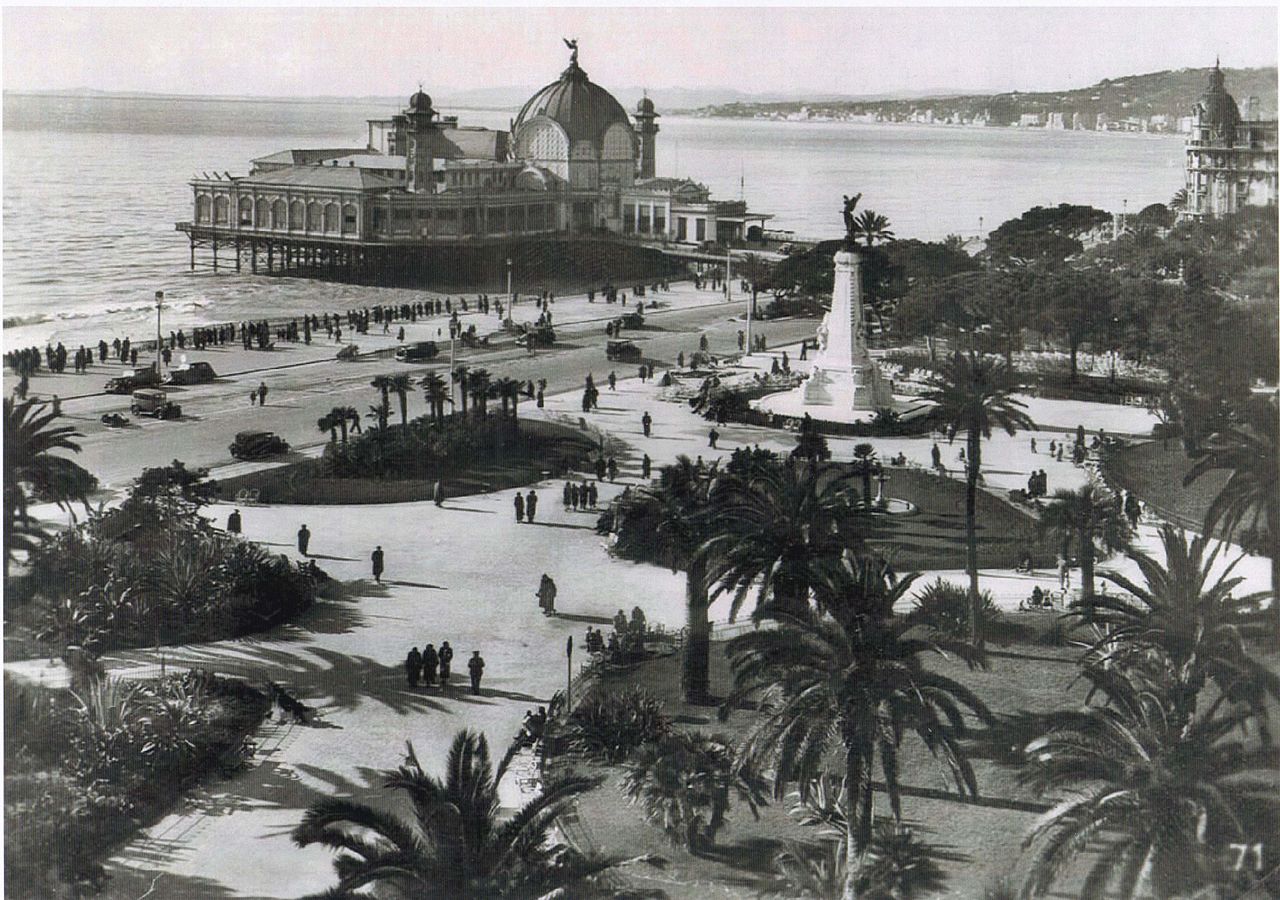
At the beginning of the 19th century, the idea of piers became very voguish and suddenly popped up along British and European coastlines, with the first piers being built in the 1850’s to give people somewhere to stroll as well as to moor ships. During this period the Victorians made their name in history for the creation of the ‘seaside holiday’. “Promenading” grew in popularity during this era and trips to the seaside were seen as a part of healthy living. In reality they were more of an excuse for high society to mingle and show off.
All this was highly anticipated during the warm months of the year, but winters in England were cold, miserable and the massive industrialization of cities led to choking pollution, dirt and smell. For the shivering wealthy, holidays weren’t limited to the home seaside. Steamboats allowed travellers to visit new countries and discover new lands.
Before the railway arrived, a trip to the south of France was a major task in itself, as it took at least two weeks to reach Nice from Calais. With the extension of the railway to Nice in 1861, things changed and by 1890 some 20 000 foreigners, mostly English and Russian were spending their winters there every year. Twenty years later this number has increased to over 150 000 each winter.
With the audience created it was now time for the city to stand out, so, to compete with the Casino in Monte Carlo (built in 1863), the city of Nice desired to build its own casino, especially after the first one, built in 1867 on the Promenade des Anglais, went bankrupt. All in the name of targeting and retaining wealthy ‘winterers’, predominantly British, that had plenty of money and aspired to escape the frosty weather at home.
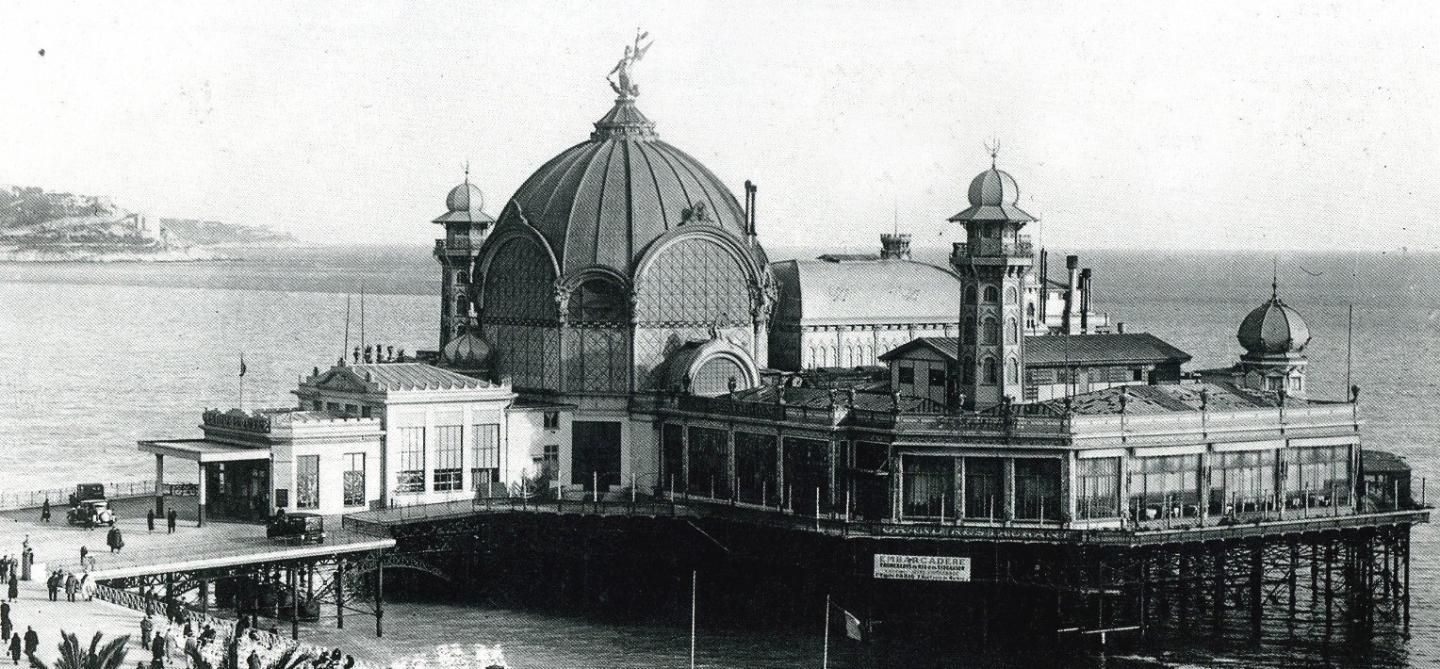
A Project is Born
A project was born, a revolutionary project, from the sea would rise an xxxx on the Nice coastline. The visionary behind the project was Marquis D’Espouy de Saint Paul. Inspired by his trip to London’s Crystal Palace, he sent a request to the Prefect of the Alpes- Maritimes for the right to have a concession on the ‘marine domain’ or ‘on the water’ in order to establish a promenade jetty “where tourists could, after paying an entrance fee, walk above the sea”. His plan was not just for the novelty but had an economical reason – the prices of plots on the promenade were astronomical, even back then!
The project vision was then drawn by engineer Eugenius Birch, the constructor of Delhi – Calcutta train line, given a green light in 1878. Necessary funds, 5 million francs (whooping 16 000 000 euros in today’s money) were speedily raised.
It was then time for the project of what would be known as ‘Casino de la Jetée-Promenade’, to be built. The soon to be architectural symbol of Belle Epoque, would be the work of super talented and innovative Scottish engineer James Brunlees. He made sure that all the materials, including 250 iron pillars necessary for the construction of 6500 m2 platform and 130 m long footbridge, made their way safely from England to Nice by boat.
The construction works started in 1880 in front of the Hôtel des Anglais (the current Méridien hotel).
But from the very beginning there was trouble, even a threat of a possible sabotage. The casino was in direct competition with another proposed plan submitted by Parisian developer Omer Lazard. He submitted a project to be carried out at his own (enormous) expense to cover the part of the Paillon river flowing through Place Massena to the sea. In return, he asked for permission to build an entertainment complex with a casino, where else, at Place Massena. The municipality was very keen and approved his project in 1879. And Mayor Alfred Borrigilone tried everything to undermine the progressing works on Casino de la Jetée-Promenade, and went as far as refusing to sign the authorization to connect the platform to the Promenade des Anglais.
Espouy gave in, when the capital slowly dried out which led to execution but thankfully other investors got involved for a fixed price of three million francs. The municipal casino wasn’t doing much better, the cost of covering the river was hugely underestimated which caused the opening to be delayed by three years (it finally opened in 1884).
The works on Casino de la Jetée-Promenade continued pretty smoothly once Mayor Borrigilone backed off. The extravagant oriental pavilion in Indo-Chinese was finished, with its prodigious dome reaching to 20 meters, the casino was complimented with an outdoor bandstand, pagoda styled kiosks, theatre, concert hall and sea baths.
The unofficial opening of the sumptuous palace was set for Sunday April 1st 1883, although the theatre wasn’t fully completed yet. The grand opening however was planned for 8th of April. Who, on this beautiful balmy day would have imagined that this ‘temple of entertainment’ would live…3 days and see the planned ‘grand opening’.
On April 4th 1883, many strollers who were savouring the gentle spring afternoon didn’t think much of the hazy, cloud like smoke that started to rise above the calm sea around 5:33pm. But in a few moments, a great cloud of smoke rose to the blue sky and an eerie crackle was heard. Built mostly from wood, the entire jetty submerged in flames. In 15 minutes, everything had collapsed…The only thing that the firefighters were able to save was the bridge.
The Suspects
Did the Mayor, probably still boiling inside about the opening, pay someone to do it and make it look like an accident? Or perhaps a director of Monte Carlo casino, fearing a competition?
Could a reckless builder finishing the remaining works in the theatre drop a cigarette butt on the floor? Or was almighty Poseidon, the god of the sea, angry at the human race for interfering with his kingdom?
We will never know. Only Hercule Poirot would be probably ever able to solve that mystery.
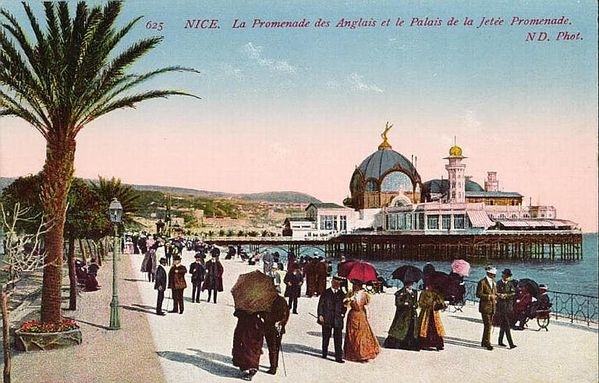
Rebirth
Five years later,a French-Belgian group decided to take over the burned down wreck of the former casino and obtained a new license from the Prefect in 1889.
The replacement Casino de la Jetee, completed in 1891 was both taller and more explicitly Oriental in design with minarets, turrets and a large dome that reached 35 metres. Atop was a golden plated trident carrying siren (in greek mythology, the sirens were beautiful but dangerous creatures that lured sailors with their enchanting voices).
Armand Moisant, who has been appointed master engineer (he is best known for the Gare de Lyon) decided to raise the platform at over 2 meters above the sea levels. It was supported by an intricate network of 250 slender stilts of cast iron screwed to the depth of 5 metres. The depth of the water varied according to the position of the pillars in relation to the beach from 2 – 10.40 metres. The connection with the beach was secured by a 60 metres long and 13 metres wide bridge. The resistance of the structure was profoundly tested when it survived the major storms that hit Nice.
Reborn from the ashes, the casino was inaugurated on January 10, 1891. Unwelcomed by the town hall who saw it as a direct competition to the municipal casino, criticized by some locals for obstructing the view of the bay of the Angles and loathed by many architects (few pointed out in horor that the building was a replica of St. Sophia in Constantinople). One of Nice’s most extreme Belle Epoque buildings was ready to become a symbol of the French joie de vivre – that buoyant joy of living.
Cradled by the mild Meditarean sea, bathed in sumptuous elegance, the casino opened its door to entertainment enthusiasts. All socialites, princes, princesses and aristocrats (no representatives of the Prefect) crossed the turnstile to get a taste of the floating island, all in great pomp! Bouquets of flowers, garlands, flickering lanterns and colorful pennants created a magical ambience. It was a great success.
The walkway lined with deck chairs was leading into two wings. The casino and lounges on one side and the restaurant, veranda and ice cream shop on the other. The central part consisted of a majestic concert hall. The musical, dance, cabaret and comedy performances were carried out both day and night.
A reading room has been allocated to the single women, one of the rare social facilities open to ladies. A family lounge was also available for those who weren’t looking for a victorian flirt or the company of a Belle Epoque courtesan.
It was said that at night, when the casino was lit up, it was one of the most captivating sights. The sound of laughter, clinking champagne glasses and music filled the air with a promise of thrill, gamble, high life and low morals. Loved or hated, it was the casino’s silhouette standing out on the sea that has become one of the most characteristic structures of the city. As a symbol of Nice it was continually represented on postcards and promotion posters and often painted by artists such as Raoulf Dufy.
The Beginning of The End
First, World War I happened. Tourism collapsed, supplies were lacking and transport was taken over for military use. The Casino was seized and converted into a shelter for wounded soldiers or refugees (like most hotels in Nice). The smell of cedar wood, champagne, cigars and heartache was replaced by the lingering odour of disinfectant and despair.
However, eventually the darkness of war began to fade away and life plus profitability soon returned to the French Riviera as early as 1922, in particular the Blue Train – an all first class sleeper train which ran between Calais, Paris and Nice (also known as ‘the train to Paradise’) made its first trip in 1922 bringing a surge of wealthy visitors once again to the city.
Despite continued prosperity and fame, the mid 1920’s marked the beginning of the end of the casino’s heyday. The eclectic Belle Epoque characterised as a time of joie de vivre – joy of living – went out of fashion, and with it, the casino was getting old and less elegant. Despite several renovation projects such as an enlargement of the pontoon and an addition of a parking lot it was simply just not enough. In 1929 a new impressive casino and hotel, the Palais de la Méditerranée, was inaugurated on the Promenade des Anglais, not far from the Casino de la Jetée, and it was such a debauchery of luxury, with its imposing staircase in white marble, precious wood, crystal chandeliers and enormous stained glass windows, the facades and interior decorations were entirely in ‘new fashionable’ Art deco style.
Casino de la Jetée had fallen on hard times but kept going and stayed open until the Second World War finally got the better of it.
Fasicst Italian troops occupied Nice and ordered Jetée Promenade Casino to close its operation on the 20th December 1942. After the surrender of Mussolinians in 1943, the Italian army was immediately replaced by unified armed forces of Nazi Germany, Wehrmacht, which took over southern France and therefore Nice.
Obeying the requirements of its new occupant, Nice had to contribute, particularly with supplies of non-ferrous metals. So it came as no surprise that the casino was stripped of all its cast iron, bronze, brass, statues, silverware and other metals, to be butchered and remelt in the name of the German war effort. So, that was it as the story goes, the very few remains of the glorified temple of wonders were left to rot in the balmy Mediterranean waters.
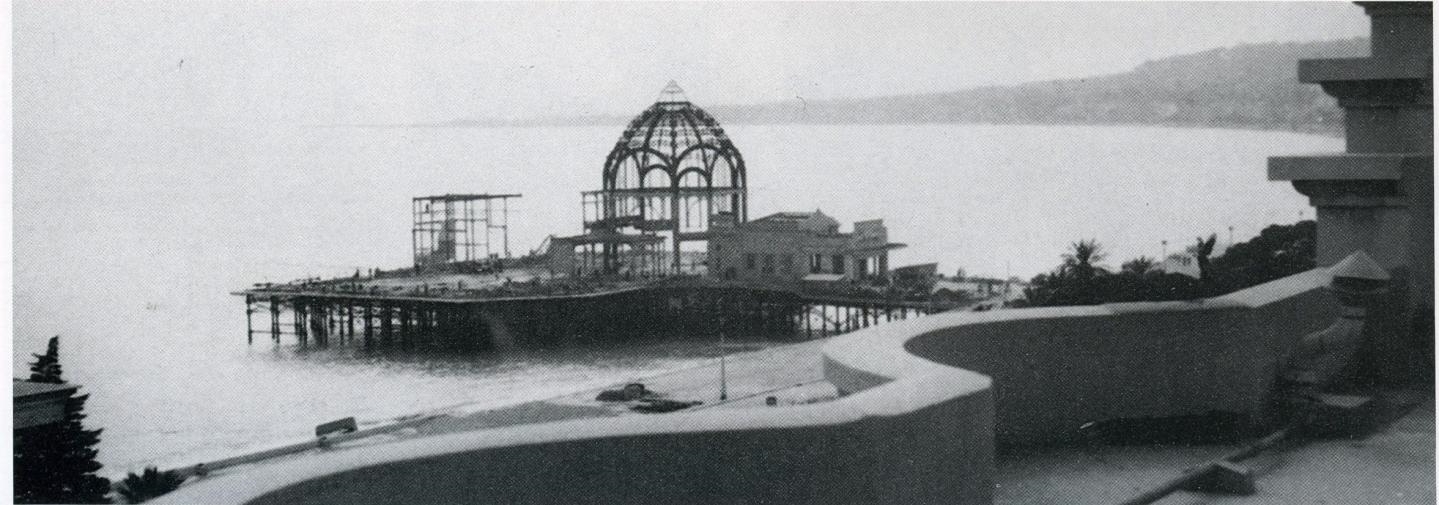
The once shining star has forever become the obscure phantom of Nice.
Next time you are walking by on a quiet night, listen. You might hear the swirl of the roulette, the orchestra playing, the laughter of the winners and cries of the losers.













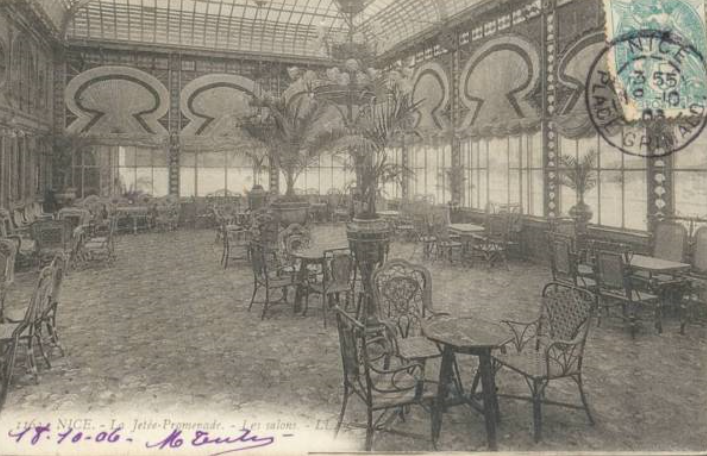
No Comments